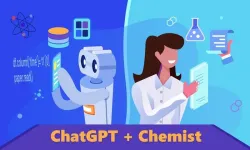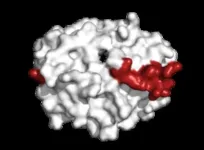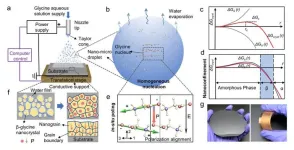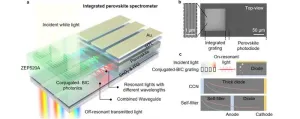Turning ChatGPT into a ‘chemistry assistant’
2023-08-10
(Press-News.org) Developing new materials requires significant time and labor, but some chemists are now hopeful that artificial intelligence (AI) could one day shoulder much of this burden. In a new study in the Journal of the American Chemical Society, a team prompted a popular AI model, ChatGPT, to perform one particularly time-consuming task: searching scientific literature. With that data, they built a second tool, a model to predict experimental results.
Reports from previous studies offer a vast trove of information that chemists need, but finding and parsing the most relevant details can be laborious. For example, those interested in designing highly porous, crystalline metal-organic frameworks (MOFs) — which have potential applications in areas such as clean energy — must sort through hundreds of scientific papers describing a variety of experimental conditions. Researchers have previously attempted to coax AI to take over this task; however, the language processing models they used required significant technical expertise, and applying them to new topics meant changing the program. Omar Yaghi and colleagues wanted to see if the next generation of language models, which includes ChatGPT, could offer a more accessible, flexible way to extract information.
To analyze text from scientific papers, the team gave ChatGPT prompts, or instructions, guiding it through three processes intended to identify and summarize the experimental information the manuscripts contained. The researchers carefully constructed these prompts to minimize the model’s tendency to make up responses, a phenomenon known as hallucination, and to ensure the best responses possible.
When tested on 228 papers describing MOF syntheses, this system extracted more than 26,000 factors relevant for making roughly 800 of these compounds. With these data, the team trained a separate AI model to predict the crystalline state of MOFs based on these conditions. And finally, to make the data more user friendly, they built a chatbot to answer questions about it. The team notes that, unlike previous AI-based efforts, this one does not require expertise in coding. What’s more, scientists can shift its focus simply by adjusting the narrative language in the prompts. This new system, which they dub the “ChatGPT Chemistry Assistant,” could also be useful in other fields of chemistry, according to the researchers.
The authors acknowledge funding from the National Institutes of Health, the Kavli ENSI Graduate Student Fellowship and the Bakar Institute of Digital Materials for the Planet.
The American Chemical Society (ACS) is a nonprofit organization chartered by the U.S. Congress. ACS’ mission is to advance the broader chemistry enterprise and its practitioners for the benefit of Earth and all its people. The Society is a global leader in promoting excellence in science education and providing access to chemistry-related information and research through its multiple research solutions, peer-reviewed journals, scientific conferences, eBooks and weekly news periodical Chemical & Engineering News. ACS journals are among the most cited, most trusted and most read within the scientific literature; however, ACS itself does not conduct chemical research. As a leader in scientific information solutions, its CAS division partners with global innovators to accelerate breakthroughs by curating, connecting and analyzing the world’s scientific knowledge. ACS’ main offices are in Washington, D.C., and Columbus, Ohio.
To automatically receive news releases from the American Chemical Society, contact newsroom@acs.org.
Follow us: Twitter | Facebook | LinkedIn | Instagram
END
ELSE PRESS RELEASES FROM THIS DATE:
2023-08-10
Québec City, August 10, 2023 - Scientists at Université Laval and the University of Lethbridge have succeeded in reversing certain cognitive manifestations associated with Alzheimer's disease in an animal model of the disease. Their results have been published in the scientific journal Brain.
"Although this has yet to be demonstrated in humans, we believe that the mechanism we have uncovered constitutes a very interesting therapeutic target, because it not only slows down the progression of the disease but also partially restores certain cognitive functions," ...
2023-08-10
CHAPEL HILL, N.C. – Platelets, or thrombocytes, are specialized cellular fragments that form blood clots when we get scrapes and traumatic injuries. Viral infections, autoimmune disease, and other conditions can cause platelet levels to drop throughout the body, termed thrombocytopenia.
After a robust clinical and research collaboration, Stephan Moll, MD, and Jacquelyn Baskin-Miller, MD, both in the UNC School of Medicine, have linked adenovirus infection with a rare blood clotting disorder. This is the first time that the common ...
2023-08-10
HOUSTON – (Aug. 10, 2023) Rice University chemist Carolyn Nichol has won a competitive Science Education Partnership Award (SEPA) from the National Institutes of Health to address race-based cancer health disparities by increasing underrepresented minority student populations’ engagement and participation in biosciences education.
The 5-year, $1,038,544 award will support Nichol’s Cancer Health Activism Network for Greater Equity (CHANGE) project in bringing together cutting-edge cancer research with insight on race-based healthcare disparities from the social sciences in a series of transformative high school biology lessons aligned with both ...
2023-08-10
PULLMAN, Wash. -- Restaurants can persuade patrons to choose healthier foods by adjusting the font size of numbers attached to nutritional information on menus, according to a study headed by a Washington State University researcher.
Lead researcher Ruiying Cai, an assistant professor in the WSU School of Hospitality Business Management, said U.S. restaurants with more than 20 locations are already required to show the calorie content of food on their menus. By representing these values incongruously — using physically larger numbers on the page when they’re attached to ...
2023-08-10
A team of researchers from the Keck School of Medicine of USC have published the first detailed description of the interplay between two cell types that allow lizards to regenerate their tails. This research, funded by the National Institutes of Health and published on August 10 in Nature Communications, focused on lizards’ unusual ability to rebuild cartilage, which replaces bone as the main structural tissue in regenerated tails after tail loss.
The discovery could provide insight for researchers studying how to rebuild cartilage damaged by osteoarthritis in humans, a degenerative and debilitating disease that affects about 32.5 million adults ...
2023-08-10
After a successful test phase, the Satellite Orbit DecAy (SODA) service, which was jointly developed by TU Graz and the University of Graz, officially became part of the ESA’s Space Safety Programme in mid-July. SODA provides accurate forecasts of the effects of solar storms on low Earth orbiting satellites. This makes TU Graz only the third Austrian institution contributing to this ESA programme. Seibersdorf Laboratories, and the University of Graz, through the Kanzelhöhe Observatory and the Institute of Physics, ...
2023-08-10
Each year, more than 200 million people fall sick with malaria and more than half a million of these infections lead to death. The World Health Organization recommends parasite-based diagnosis before starting treatment for the disease caused by Plasmodium parasites. There are various diagnostic methods, including conventional light microscopy, rapid diagnostic tests and PCR.
The standard for malaria diagnosis, however, remains manual light microscopy, during which a specialist examines blood films with a microscope to confirm the presence of malaria parasites. ...
2023-08-10
A research team led by The Hong Kong University of Science and Technology (HKUST) has developed a novel technique to self-assemble a thin layer of amino acids with ordered orientation over a large area that demonstrates high piezoelectric strength, making the manufacturing of biocompatible and biodegradable medical microdevices, such as pacemaker and implantable biosensor, in the near future possible.
The generation of bioelectricity from the piezoelectric effect – reversible conversion between mechanical and electrical energies – has physiological significance in living systems. ...
2023-08-10
Acquiring real-time spectral information in point-of-care diagnosis, internet-of-thing, and other lab-on-chip applications require spectrometers with hetero-integration capability and miniaturized feature. Compared to conventional semiconductors integrated by heteroepitaxy, solution-processable semiconductors provide a much-flexible integration platform due to their solution-processability, and, therefore, more suitable for the multi-material integrated system. However, solution-processable semiconductors are usually incompatible with the micro-fabrication processes, making them far from practical use in various lab-on-chip applications.
In a new paper published ...
2023-08-10
Immunothrombosis, or the formation of microscopic blood clots during inflammation, is a major cause of morbidity among patients with sepsis or severe COVID-19. A key enzyme in this process is thrombin. To date, no method exists for early detection of immunothrombosis in a living organism.
A team of investigators led by Ali Hafezi-Moghadam, MD, PhD, director of the Molecular Biomarkers Nano-Imaging Laboratory (MBNI) at Brigham and Women’s Hospital, a founding member of Mass General Brigham healthcare system, and an associate professor of Radiology at Harvard Medical School, developed a novel technology to diagnose immunothrombosis by measuring ...
LAST 30 PRESS RELEASES:
[Press-News.org] Turning ChatGPT into a ‘chemistry assistant’








